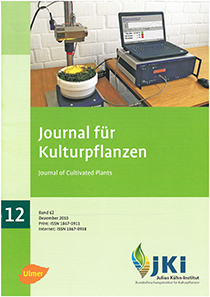Use of a <em>Sapindus mukorossi</em>-extract to regulate fungal pathogens on vines – an alternative strategy for organic grape protection?
DOI:
https://doi.org/10.5073/JfK.2010.12.02Keywords:
Sapindus mukorossi, Guignardia bidwellii, Plasmopara viticola, Vitis vinifera, organic viticulture, alternative controlAbstract
In greenhouse experiments on leaves of Vitis vinifera (L.) a water-extract of shells of the Chinese Soapberry (Sapindus mukorossi) indicated an excellent efficacy against Guignardia bidwellii (causal agent of black rot) and Plasmopara viticola (causal agent of downy mildew). Regarding G. bidwellii, this effect was principally confirmed on clusters in the field. Here, when application takes place immediately prior to inoculation the observed efficiency (75 to 90%) was comparable to standard products applied in organic viticulture (Thiovit Jet®, a.i. sulphur) or integrated grape production (Polyram® WG, a.i. metiram). However, the duration of activity in the vineyard seems to be limited. In a field trial with a seven day application interval the efficacy of the water-extract of Sapindus mukorossi reached around 50%.
The control of Plasmopara viticola in the field was even more difficult. Contrary to the results in the greenhouse, the potential of a water-extract of Sapindus mukorossi to control Plasmopara viticola was – at least in the growing period 2008 with prevailing low disease pressure – not evident.
Downloads
Published
Issue
Section
License
The content of the journal is licensed under the Creative Commons Attribution 4.0 License. Any user is free to share and adapt (remix, transform, build upon) the content as long as the original publication is attributed (authors, title, year, journal, issue, pages).
The copyright of the published work remains with the authors. The authors grant the Journal of Cultivated Plants, the Julius Kühn-Institut and the OpenAgrar repository the non-exclusive right to distribute and exploit the work.







